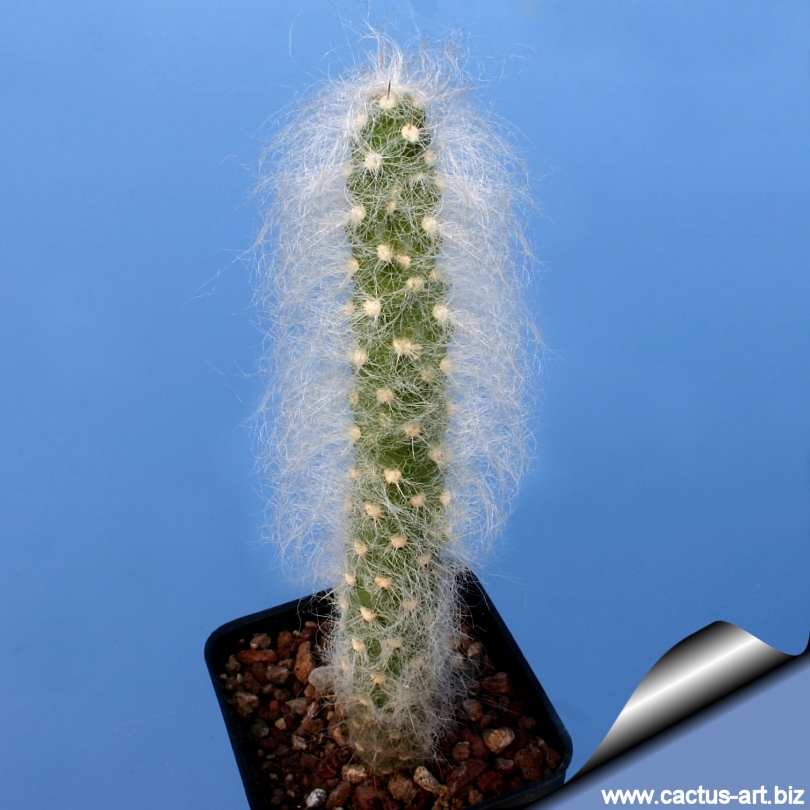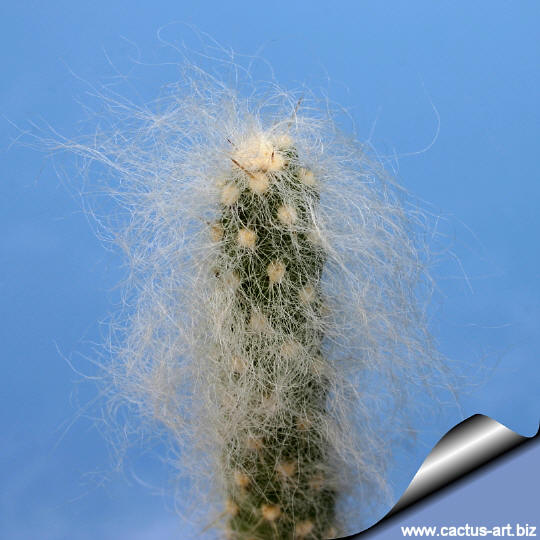|
|
|

Austrocylindropuntia vestita
It forms slim columns densely cloaked with thin long white hairs.
Every one has it, grows and flowers well.
|
|
Description:
It is
usually
a
slender
columnar white and very furry cactus
from high altitude.
The standard plants form
branch both basally and near the top of the stems.
Stems:
Cylindrical 2-3 cm in diameter covered densely with long white hairs.
The stems can eventually grow to
almost 60 cm tall.
Leaves:
Thin subulate,
caducous (but lasting from spring to autumn if the plant is kept
regularly watered)
Spines:
Few thin, up to 1 cm long and white. The plant has also abundant long,
fine and rubbery hairs which completely cover the branches.
Flowers:
A. vestita
is not a reliable
bloomer. When flowering finally occurs, the flowers will be a beautiful
deep red or
violet up to 2-2,5cm . The hairiness of the
pericarpel is mostly as dense as that of the stems, merely the
spination remains less. The flowers are developed always at the top of
the stems.
|
| |
|
Cultivation:
This particular species needs
regular watering
when soil is dry
during the
growing seasonis
but it is prone to root rot, so prudent watering is necessary.
Keep dry in winter. I comes from high altitude
and do not like hot, stuffy
summers, it is best to put them in airy places
with ample airflow.
It requires
a very
drained and
mineral potting mix and a full sun or slightly
shady exposure.
Protect from severe frost.
Propagation: Seeds are seldom
available and extremely difficult to
germinate. Best reproduced by
cutting that produce roots easily.
The crested variety, which is
more delicate, multiplies more easily using grafting.
NOTE: The genus
Austrocylindropuntia comprises eleven species and was created by
Curt Backeberg in 1938 for the cylindrical Opuntias of South-America.
The cylindrical Opuntias of North-America was instead placed in the
genus Cylindropuntia.
Austrocylindropuntia can easily be distinguished from
Cylindropuntia: Cylindropuntia spines have papery sheaths,
Austrocylindropuntia spines lack them. Austrocylindropuntia
have cylindrical stems that grow indeterminately, not like many other
Opuntias with stems that grow in a single season. Fresh stems have
noticeable leaves that soon fall off. Austrocylindropuntias form low
cushions o bushes up to 3 of 5m. The seeds are different too.
Photo of conspecific taxa, varieties, forms and
cultivars of Austrocylindropuntia vestita.
|
|
Advertising
|
|
|
|
Kingdom: Plantae (plants)
Divisio: Magnoliophyta (Flowering Plants)
Class: Rosopsida - (Eudicots )
Order: Caryophyllales »
Family:
Cactaceae (Cactus
Family)
Scientific name: Austrocylindropuntia
vestita (Salm-Dyck) Backeberg
1939
Origin: Bolivia
Conservation status: Listed in
CITES appendix 2.
Common English Names include:
"Cotton Coral Cactus", "Cotton Pole", "Old
Man Opuntia"
Etymology: The species name
"vestita" refers to the plants' vestments, its
clothing of white hairs that turns into dens colonies what appears to be
patches of snow remembering the high mountain peaks that surround - on
all sides - the habitat of this plant.
Synonyms:
- Austrocylindropuntia
chuquisacana (Cárdenas) F.Ritter, 1980
- Austrocylindropuntia teres
(Cels ex F.A.C.Weber) Backeberg, 1944
- Cylindropuntia teres (Cels
ex F.A.C.Weber) Backeberg, 1935
- Cylindropuntia vestita (Salm-Dyck)
Backeberg, 1936
- Maihueniopsis vestita (Salm-Dyck)
R.Kiesling, 1998
- Opuntia chuquisacana
Cárdenas, 1950
- Opuntia heteromorpha
Philippi, 1891
- Opuntia teres Cels ex
F.A.C.Weber, 1898
- Opuntia vestita
Salm-Dyck, 1845
- Tephrocactus heteromorphus
(Philippi) Backeberg,
|
|
|
|


 |
|